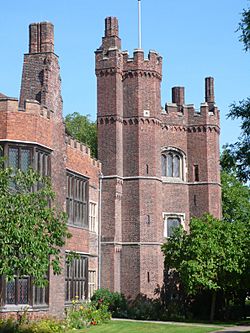Gainsborough Old Hall facts for kids
Quick facts for kids Gainsborough Old Hall |
|
|---|---|

Old Hall Tower
|
|
| OS grid reference | SK 81320 90012 |
| Built | 1471–1484 |
| Architectural style(s) | Tudor |
|
Listed Building – Grade I
|
|
| Designated | 4 April 1964 |
| Reference no. | 196291 |
| Lua error in Module:Location_map at line 420: attempt to index field 'wikibase' (a nil value). | |
Gainsborough Old Hall is a really old and amazing building in Gainsborough, Lincolnshire. It is over 500 years old! This hall is one of the best-preserved medieval manor houses in all of England. It is like stepping back in time to the days of knights and kings.
Contents
History of Gainsborough Old Hall
Building the Hall and Royal Visitors
The Old Hall was built by a powerful and wealthy man named Sir Thomas Burgh around 1460. The Burgh family was very important and loved to show off their wealth. The Hall was not just their home; it also showed everyone how rich and important they were. Sir Thomas also helped build a church in Newark and founded a special house for poor people in Gainsborough.
In 1470, the Hall was attacked by Sir Robert Welles because of a disagreement over land and power. Luckily, the building was not badly damaged. Later, in 1484, Sir Thomas had a very important guest: King Richard III himself!
A Royal Visit from King Henry VIII
King Henry VIII visited Gainsborough Old Hall twice. His first visit was in 1509. He came back again in 1541 with his fifth wife, Queen Katherine Howard. Sadly, Queen Katherine was later accused of doing things she shouldn't have. She was executed after her visit to Gainsborough and Lincoln. Later, Katherine Parr, who had been married twice before, became Henry's sixth wife.
A Home for Dissenters
After the fifth Lord Burgh passed away without children, the Hall was sold in 1596. A merchant from London named William Hickman bought it. He made many improvements, especially to the east side of the building.
William and his mother, Rose, were very supportive of the Puritans. These were people who wanted to change the Church of England. They allowed John Smyth, Thomas Helwys, and other Puritans to hold their church services in the Hall in the early 1600s. These groups later sailed to the Netherlands to escape being treated badly. There, they started the Baptist church. The Hickman family continued to be important in Gainsborough for many years. They even had family members who became members of Parliament.
Later, in the 1700s, another famous person visited the Hall. Sir Neville Hickman invited John Wesley, a very important religious leader, to preach in the Great Hall several times. He preached there in 1759, 1761, and 1764.
The Hall Becomes Empty
Around 1720, the Hickman family built a new house outside of town. Gainsborough Old Hall then became empty. It stayed in the family but was used for different things over the years.
What the Hall Looks Like
Gainsborough Old Hall has not changed much over hundreds of years. It is mostly a timber-framed building. This means it has a special "striped" or "black and white" look because of the wood and plaster used. On the north-east side, there is a brick tower. If you climb the 59 steps to the top of the tower, you can get an amazing view of the town!
Today, you can still see the Hall's beautiful timber roof. The kitchen is also very special. It might be the most complete medieval kitchen in all of England! It still has many of its original features. There are two huge fireplaces, each big enough to roast a whole ox! There are also two ovens for baking bread, which share a third chimney.
Mysterious Marks on the Walls
The Hall has many "witches' marks" carved into its walls. People in the past believed these marks would protect them from evil spirits and bad luck. You can also see many burn marks, which were thought to protect the building from fire.
The Legend of the Grey Lady
The tower of Gainsborough Old Hall is said to be haunted by a ghost called the Grey Lady. The story says she was the daughter of the Lord of the Manor. She fell in love with a poor soldier and planned to run away with him. But her father found out! He locked her in the tower, and she sadly died there from a broken heart. Local legends say that her ghost still walks the tower, always waiting for her true love to arrive.
The Hall Today
From 1949, a group of volunteers called The Friends of the Old Hall (FOHA) took care of the building. They saved it and were the first to open it to the public. In 1970, Sir Edmund Bacon gave the Hall to the country.
Today, English Heritage owns Gainsborough Old Hall. It is open to the public as a museum, so you can visit and explore it! It is also a "Grade I listed building," which means it is a very important historic site that needs to be protected. The Friends of the Old Hall group still exists. They help by providing volunteer guides and sharing their knowledge about the Hall.
Images for kids





